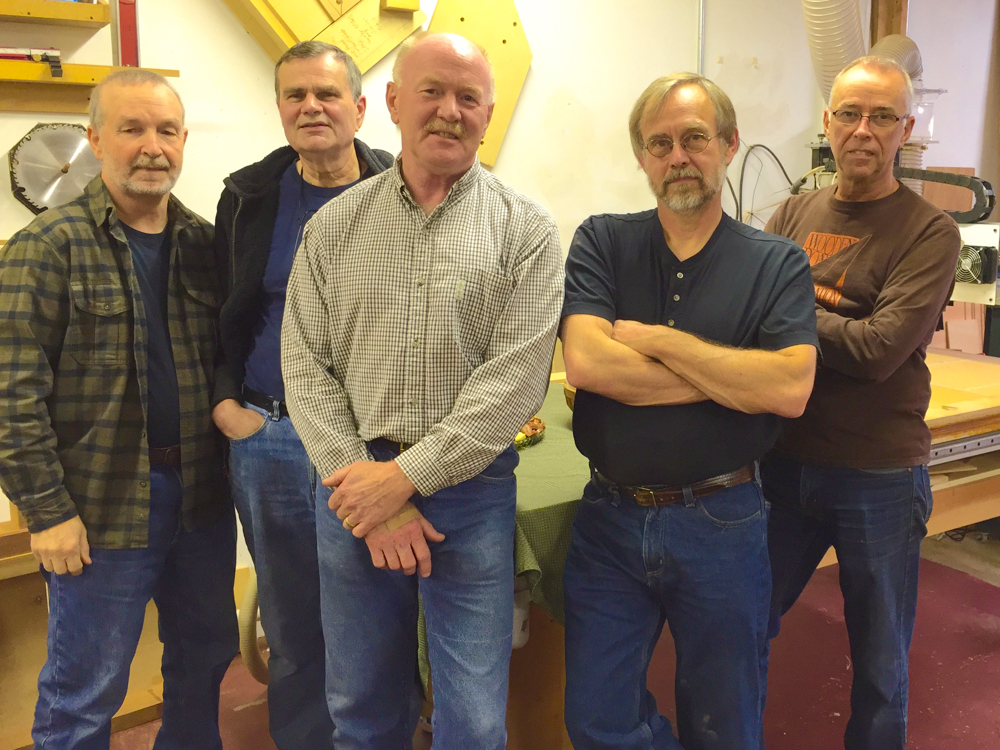We may receive a commission when you use our affiliate links. However, this does not impact our recommendations.

User groups work. Some of the members of my user group — all woodworking professionals and all serious CAD and CNC users. From the left, myself, Curtis Erpelding, George Knutson, Darrell Peart, and Bob Spangler. Showing up a few minutes later were David Myka and Reid Anderson.
In the December 2017 Popular Woodworking article called “Digital Artistry… How five masterful makers integrate CNC and CAD technology into their woodworking”, five professional woodworkers showed how they’ve added digital woodworking skills and tools to their traditional, hybrid and hand tool woodworking skill sets. The makers are Darrell Peart, Curtis Erpelding, Bob Spangler, David Myka and myself. All of us have traditional woodworking backgrounds but have embraced new technologies as a way to increase our creative possibilities.
Adding new tools and technology has been, and continues to be, interesting and challenging for all of us, to say the least. As pointed out in the article, we all know each other. We’re friends and members of a small group of woodworking professionals and a few hobbyists that meet regularly to exchange ideas and techniques as we explore this new digital woodworking world. We’ve found that by meeting in person and sharing what we know, we’ve all benefited. Accelerated learning, growing digital woodworking skill set, finding new ways to blend digital with traditional and refinement in our individual use of these tools are the results. That’s the power of user groups. If you’re interested in using digital woodworking tools, a user group is a great way to get off to a fast start.
Why User Groups?
User groups are small to medium size organizations where volunteer members get together to share information, experience and discoveries. Timing wise, they frequently crop up when new technology is involved. When everything is so new, everyone is particularly open to learning. Experts and beginners get together to share what they know and all benefit. It really works.
I’m a big fan of user groups. Since the mid-80’s I’ve been involved with a number of them. They’re one of the best ways I know to learn, share, grow and solve individual problems. My recommendation: if you want to get started in digital woodworking and move past the usual problems we all struggle with when taking on new technology, join a user group in your area.
It takes little effort to find or start a user group. If you put out the word via Craigslist, social media or word of mouth, you’ll find there are a lot of people nearby — just like you, who are just as interested in using these digital tools as you are. Another approach if you have a woodworking guild nearby, is that it’s likely that a number of people are interested or already use tools like CAD and CNCs. So, seek them out, join together and meet at each others’ shops to exchange what you know. Plus, because of the “Maker Movement”, woodworkers are not the only ones who want to learn about CNC machines and CAD software. Different experiences and perspectives are a good thing when it comes to CNCs. —more possibilities, more ideas and even more to share.
Sharing is the secret
When it comes to woodworking, everybody has a slightly different interest and focus. We all use combinations of tools and methods in different ways. Adding CNCs, CAD and other digital tools just add to the mix. But, these tools are indeed different when compared to anything we’ve added to our shops, since the beginning of the industrial age. That means learning how to use them requires a different approach as well. You can learn a lot from online sources, videos, and blogs, such as this one, but nothing beats face-to-face learning and sharing. And, that’s where user groups come in. Join one. Form one. Invite everybody you know who have an interest in digital tools and share everything. Everyone will learn faster and along the way, discover and create new ways to use these exciting new woodworking tools.
Additional Resources
- Classes I’m teaching this summer at the Marc Adam’s School of Woodworking
- Digital Woodworking on Instagram
- Personal Work on Instagram
- Digital Woodworking YouTube Channel
Here are some supplies and tools we find essential in our everyday work around the shop. We may receive a commission from sales referred by our links; however, we have carefully selected these products for their usefulness and quality.








